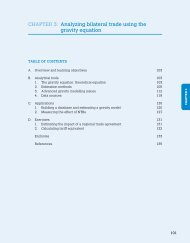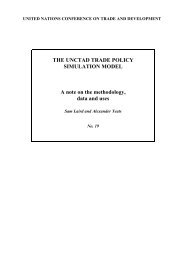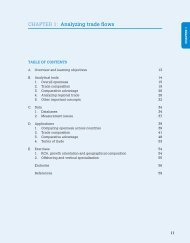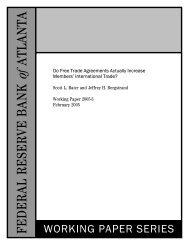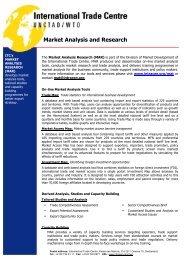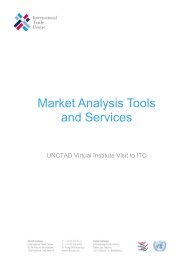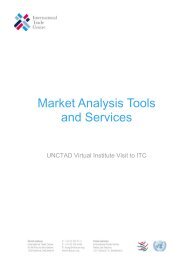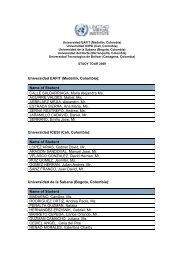UNCTAD's Debt Management and Financial Analysis System (DMFAS
UNCTAD's Debt Management and Financial Analysis System (DMFAS
UNCTAD's Debt Management and Financial Analysis System (DMFAS
You also want an ePaper? Increase the reach of your titles
YUMPU automatically turns print PDFs into web optimized ePapers that Google loves.
E. Analytical function1. Projections based on outst<strong>and</strong>ing <strong>and</strong> present value calculationsThe analysis module has been specifically designed to calculate projections based on outst<strong>and</strong>ing, <strong>and</strong> thepresent value amount using CIRRs as the rates of discount, of a debt portfolio.Because debt indicators based on the nominal value of a debt are static, they may not exactly reflect acountry’s underlying solvency. Unlike nominal value, present value takes into account the terms <strong>and</strong> theconcessionality of a debt portfolio while reflecting the costs of servicing it in “today’s money”. <strong>Debt</strong>indicators based on present value are a more appropriate measure to apprehend a country’s solvency <strong>and</strong> itsdebt servicing situation. Present value allows debt officers to more easily compare debt portfolios betweencreditors by eliminating the effects of concessionality.The module on projections based on outst<strong>and</strong>ing is useful when the user needs to calculate:• The amount of interest due in the near future (for example, the amount of interest to be paid in the nextmonth), the cash flow needs of the central bank; etc.• Future debt service payments for a loan in which he foresees a cancellation of the undisbursed amount.• A debt’s present value for the purposes of analysis such as in the framework of the HIPC initiative.This module enables the user to choose between different parameters <strong>and</strong> calculation methods (the pro-rata<strong>and</strong> the truncation methods) of particular interest to produce <strong>and</strong> compare different scenarios for the debtsustainabilityanalysis of HIPC.2. Interface with the <strong>Debt</strong> Sustainability Model (DSM+)of the World BankAn interface has been created between <strong>DMFAS</strong> <strong>and</strong> DSM+, which is a tool designed to help officialsanalyze the external financing requirements of a country <strong>and</strong> to quantify the effects of debt-relief operationsor new borrowing. This interface provides the <strong>DMFAS</strong> user with the means to export data from the <strong>DMFAS</strong>system for subsequent import into DSM+.3. Other analytical features<strong>DMFAS</strong> system also provides analytical support for debt managers by, for example:• Facilitating easy registration of potential new debt <strong>and</strong> analyzing the effect of these new debts on thefuture debt-service pattern;• Permitting easy simulations to determine the effect of interest rate fluctuations <strong>and</strong> exchange ratevariations over a period of time;• Calculating <strong>and</strong> giving information on detailed penalty interest from the scheduled date of a maturityregistered as an arrear to a given date; <strong>and</strong>• Calculating accrued interest. <strong>DMFAS</strong> allows debt officers to generate automatically such information,at the end of the previous month, for use by other departments, including the accounting unit.18



